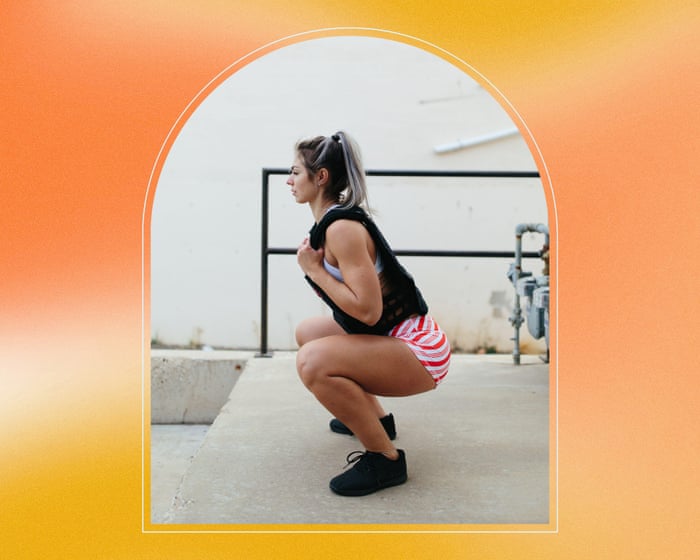A few months ago, I noticed something strange. Suddenly, it seemed like every third person on the street was wearing a small, heavy backpack. At first, I even mistook some of them for bulletproof vests (which was unsettling). Then I realized it was just the latest fitness craze: weighted vests.
Celebrities have been spotted wearing them on walks, Peloton instructors are making tutorial videos, and influencers are promoting them on TikTok. Publications like Allure have written about their growing popularity, especially among women going through menopause, since they’re said to help with muscle strength and bone density as we age.
“It’s really gained a lot of attention lately,” says Dr. Elaina Manolis, a physical therapist and professor at Northeastern University. She notes that the practice used to be called “rucking” because people would walk with heavy backpacks.
Manolis thinks part of the appeal is that modern weighted vests are sleeker and more stylish than bulky backpacks. She also believes it reflects a broader shift in attitudes toward women’s health and the importance of strength training.
But are weighted vests really the workout miracle they’re made out to be? I tried one for two weeks and asked experts for their thoughts.
What is a weighted vest?
These vests are filled with iron sand or small weights to add extra resistance. “Think of it as ‘hyper-gravity,'” says Dr. Abbi Lane, an exercise science professor at the University of Michigan. They typically range from 5 to 30 pounds (2.26 to 13.6 kg) and are worn over the shoulders and torso. Some are compact with chest straps, while others look alarmingly like bulletproof vests.
“Start with a vest that’s no more than 5-10% of your body weight and gradually increase,” advises Dr. Mary Claire Haver, an OB-GYN and menopause specialist. I opted for a 16-pound (7.25 kg) vest from Prodigen—comfortable enough that I didn’t look like I was heading to a shooting range.
How do you use a weighted vest?
Unlike other fitness gear, weighted vests can be worn during everyday activities. “You might do resistance training at the gym twice a week, but you can wear the vest while walking or doing chores,” says Lane.
Still, moderation is key, especially at first. “I don’t recommend wearing it every day,” warns Manolis. Daily movements involve a lot of bending and twisting, which increases injury risk when extra weight is added.
Manolis suggests wearing the vest while walking—an underrated exercise—since staying upright minimizes injury risk. Once comfortable, Haver says you can try light aerobics, strength training, or even short runs, but always listen to your body. “Start with short sessions and work up to 20-30 minutes a day,” she advises.
What does it feel like?
For two weeks, I wore my vest twice while walking on the treadmill, watching Vera on my iPad. At first, the weight felt oddly comforting—like a thunder shirt for anxious dogs. But as I started moving, I was surprised by how unsteady I felt. It took a few minutes to adjust my stride, and staying upright required more core strength than I expected.Here’s a more natural and fluent version of your text while keeping the original meaning:
By the time my 30 minutes were up, DCI Vera Stanhope had figured out that something was off about her murder case, and I was breathing much harder than normal. Why did this feel tougher? I used to weigh 16 pounds more than I do now, and I don’t remember feeling this exhausted during walks back then.
Lane explains that with a weighted vest, “the weight isn’t evenly distributed across your body. When I carried those extra 16 pounds naturally, my arms and legs were bigger too. But with the vest, all the weight sits in one spot, forcing you to adjust your balance.” This challenges your stability, but it’s important not to use a vest so heavy that it changes how you walk. “That’s how injuries occur,” she adds.
Over time, I got used to the vest and didn’t feel as off-balance. The walks felt more intense but not uncomfortable.
What are the benefits?
Manolis says weighted vests offer several advantages. The extra weight makes your muscles work harder, which can build strength over time. Your body also burns more calories since moving requires more energy. Some research suggests weighted vests might help prevent bone loss in postmenopausal women, who are at higher risk for conditions like osteoporosis. Manolis thinks this might be because the downward pressure helps bones repair themselves faster.
However, Lane cautions that most studies on this have been small – fewer than 20 people. The largest study (with 150 participants) found that weighted vests didn’t prevent bone loss in older adults trying to lose weight. “The research isn’t very comprehensive yet,” Lane admits.
Despite this, weighted vests can still be useful. “We’re finally paying attention to muscle and bone loss in middle-aged women,” says Haver. “Weighted vests are a simple, affordable way to help with that.” But they work best when combined with other exercises. “I see them as the cherry on top,” Lane adds. “Helpful, but no substitute for cardio and strength training.”
What are the risks?
The main dangers come from using a vest that’s too heavy or wearing it too long. “It can strain joints, cause poor posture, or lead to back/knee pain,” Haver warns. She emphasizes proper fit and gradual use – and stopping if you feel any discomfort. “Never push through pain,” she advises.
My verdict:
I’ve worn the vest a few more times since my trial. I don’t love how sweaty it makes me, and I’m unsure how to clean it properly (I’ve been using wipes – don’t judge). But it does add some challenge and variety to my walks. That said, I probably won’t make it a regular part of my routine. As someone who strength trains several times a week, I find heavy squats more effective and satisfying for building leg and bone strength than walking with extra weight.
Though I did enjoy looking like an action movie star.Here’s a more natural and fluent version of your text:
“Total hero though. When I asked my partner how I looked in it, he just said, ‘Tactical.’ Way cooler than my usual gym outfit—just a sweaty 30-something in a Rainforest Cafe T-shirt.”
This keeps the original meaning and tone while making it sound more conversational. Let me know if you’d like any tweaks!



